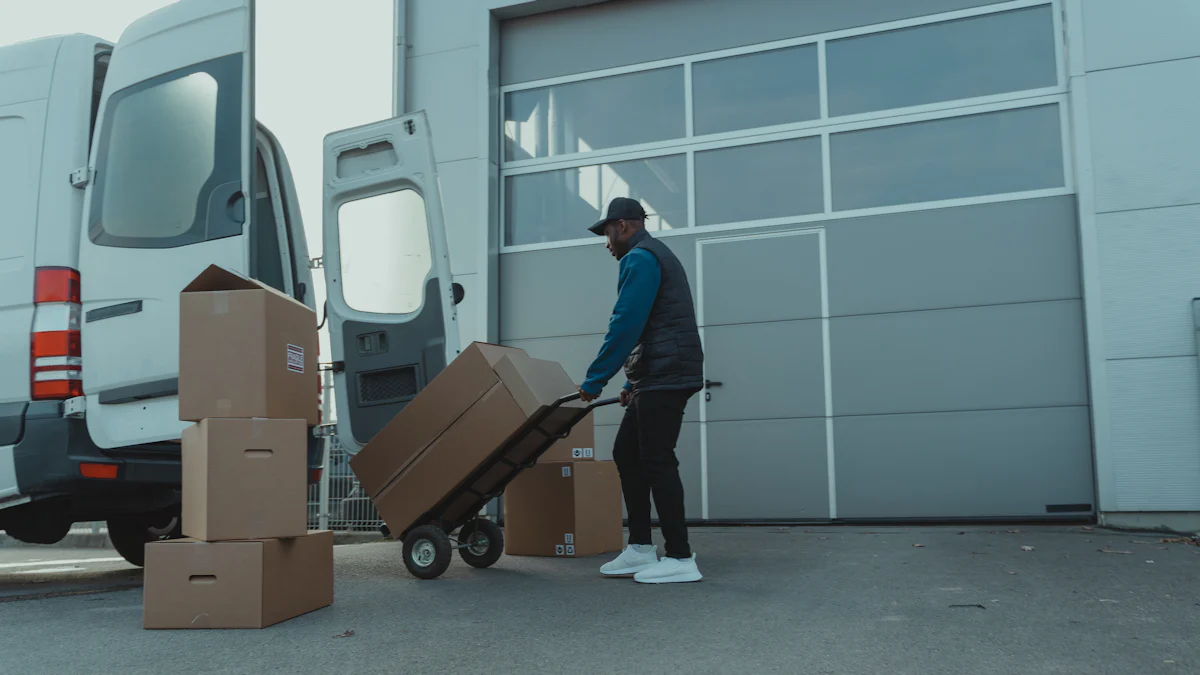How to Choose the Right Box Vehicle: From Space Requirements to Practical Applications

Choosing the right box truck size plays a vital role in ensuring smooth and efficient transportation. A truck that’s too small forces you to make multiple trips, wasting time and increasing costs. On the other hand, an oversized truck leads to unused space and unnecessary expenses. By carefully assessing your cargo’s dimensions and volume, you can avoid these pitfalls. Standard box truck sizes range from 10 to 26 feet, offering options for various needs. Proper planning and estimation help you select a truck that fits your requirements while keeping operations cost-effective.
Key Takeaways
Assess your cargo dimensions and volume accurately to choose the right box truck size, avoiding unnecessary trips or costs.
Understand the Gross Vehicle Weight Rating (GVWR) to ensure your truck can safely carry your cargo without exceeding legal limits.
Utilize efficient packing techniques, such as stacking items and using pallets, to maximize space and ensure the safety of your cargo during transport.
Consider the specific applications of different box truck sizes to match your needs, whether for small moves, medium deliveries, or large-scale transportation.
Factor in costs, including rental fees and fuel efficiency, to make a financially sound decision when selecting a box truck.
Secure adequate insurance coverage for your cargo and vehicle to protect against potential damages or accidents during transit.
Plan your packing layout in advance to optimize space and ensure easy access to frequently used items during unloading.
Understanding Your Space Requirements for Box Truck Sizes

Choosing the right box truck begins with understanding your space requirements. Proper planning ensures that you select a truck that accommodates your cargo efficiently while avoiding unnecessary costs. Let’s explore the key factors to consider when determining the ideal truck size.
Assessing Cargo Dimensions and Volume
Measuring the size and volume of your cargo
Start by measuring the dimensions of your cargo. Use a tape measure to determine the length, width, and height of each item. Multiply these measurements to calculate the volume in cubic feet. For multiple items, sum up their volumes to get the total space required. This step helps you visualize how much room your belongings will occupy in the truck.
Considering irregularly shaped or fragile items
Not all items fit neatly into boxes. Irregularly shaped or fragile items, such as furniture or glassware, require special attention. These items may need extra padding or space to prevent damage during transit. Factor in this additional space when estimating your total cargo volume.
Weight Capacity and Legal Limits
Understanding gross vehicle weight rating (GVWR)
The Gross Vehicle Weight Rating (GVWR) indicates the maximum weight a truck can safely carry, including its own weight and the cargo. Box trucks typically have GVWRs ranging from 8,000 to 33,000 pounds. Always check the GVWR of the truck you plan to use to ensure it meets your needs.
Avoiding overloading to comply with regulations
Overloading a truck can lead to fines, safety hazards, and damage to the vehicle. Stay within the truck’s weight limit to comply with legal regulations. If your cargo exceeds the limit, consider renting a larger truck or making multiple trips.
Packing Efficiency in JUSDA Warehouses
Maximizing space with proper packing techniques
Efficient packing plays a crucial role in optimizing space. Stack items neatly and use every inch of available room. Place heavier items at the bottom and lighter ones on top to maintain balance. This approach not only saves space but also ensures the safety of your cargo.
Using pallets, boxes, or other organizational tools
Organizational tools like pallets and boxes simplify the packing process. Pallets allow you to group items together, making loading and unloading faster. Boxes protect smaller items and make them easier to stack. At JUSDA warehouses, these tools are essential for maximizing storage efficiency and ensuring smooth logistics operations.
Types of Box Trucks and Their Practical Applications

Selecting the right box truck depends on your specific needs and the nature of your cargo. Each truck size offers unique advantages, making it essential to understand their practical applications. Below is a breakdown of the most common box truck sizes and how they can serve you.
Small Box Trucks (10-14 feet)
Ideal for small moves or deliveries
Small box trucks are perfect for light-duty tasks. These trucks typically handle payloads ranging from 10,000 to 16,000 pounds, making them suitable for transporting lightweight goods. If you’re moving out of a studio apartment or a one-bedroom home, this size works well. Their compact design allows easy navigation through urban areas and tight spaces, ensuring smooth delivery operations.
Commonly used by small businesses or for personal use
Small businesses often rely on these trucks for local deliveries. They are ideal for parcel delivery, furniture moving, or transporting small quantities of materials. Their maneuverability makes them a practical choice for personal use, especially when you need to move items in crowded city environments.
Medium Box Trucks (15-20 feet)
Suitable for medium-sized moves or larger deliveries
Medium-sized moving trucks offer a balance between capacity and versatility. With a payload capacity ranging from 16,000 to 26,000 pounds, these trucks are excellent for medium-sized moves. They can accommodate furniture, appliances, and other household items from two- to three-bedroom homes. This makes them a popular choice for families or businesses with moderate transportation needs.
Popular for furniture, appliances, or retail goods
These trucks are widely used in industries like retail and logistics. Businesses often use them to transport furniture, appliances, or palletized freight. Their larger cargo space ensures that you can move bulkier items efficiently. If you’re considering a moving truck rental for a medium-sized relocation, this option provides the space you need without being overly large.
Large Box Trucks (22-26 feet)
Best for large-scale moves or commercial applications
Large-sized moving trucks are designed for heavy-duty tasks. They are ideal for transporting goods from larger homes with multiple bedrooms or for commercial purposes. These trucks can handle significant payloads, making them suitable for bulk transportation or large-scale relocations.
Used by moving companies or for bulk transportation
Moving companies frequently use these trucks for their capacity and reliability. They are perfect for transporting household goods, retail products, or even machinery. If the size of your home requires a truck that can carry a substantial amount of cargo, this is the best choice. These trucks also serve industries that need to move large quantities of goods efficiently.
Pro Tip: When choosing a moving truck size, always consider factors like the volume of your cargo, the distance of your move, and the type of items you’re transporting. This ensures you select the most cost-effective and practical option.
How to Estimate the Right Truck Size for Your Needs
Selecting a moving truck that fits your needs requires careful planning. Estimating the right size moving truck ensures you avoid unnecessary costs and logistical challenges. Follow these steps to make an informed decision.
Calculating Cargo Volume
Using cubic feet as a measurement
Start by measuring the dimensions of each item you plan to transport. Multiply the length, width, and height of every item to calculate its volume in cubic feet. Add up the volumes of all items to determine the total space required. This method provides a clear picture of how much room your belongings will occupy in the truck. Most box truck sizes are listed in cubic feet, making this calculation essential for accuracy.
Factoring in extra space for safety and accessibility
Always account for extra space when estimating your cargo volume. Items like furniture or fragile goods may need additional padding or careful stacking, which takes up more room. Leave some space for accessibility to ensure you can load and unload items without difficulty. Booking a truck slightly larger than your calculations can help accommodate unexpected needs and prevent last-minute issues.
Pro Tip: Online tools, such as moving calculators, can simplify this process. Input your item dimensions to visualize the required truck size.
Matching Truck Dimensions to Cargo Needs
Comparing truck interior dimensions to your cargo
Compare the interior dimensions of the truck to the size of your home and the items you plan to move. For example, u-haul moving truck sizes often include detailed specifications for length, width, and height. Ensure the truck’s interior can comfortably fit your largest items, such as sofas or appliances. This step helps you avoid surprises on moving day.
Accounting for loading and unloading ease
Consider how easily you can load and unload your items. Trucks with ramps or lift gates simplify the process, especially for heavy or bulky goods. Ensure the truck’s design aligns with your needs to save time and effort during the move.
Step-by-Step Guide to Estimate the Right Truck Size
Listing all items and their dimensions
Create a comprehensive list of everything you plan to transport. Include furniture, boxes, and any irregularly shaped items. Measure each item and note its dimensions. This step ensures you don’t overlook anything important.
Summing up total volume and weight to find the best fit
Add up the total volume of your items to estimate the right truck size. Consider the weight of your cargo as well, as trucks have specific capacity limits. For instance, box trucks with higher payload capacities are ideal for heavier loads. If your calculations suggest a borderline case, choose a slightly larger truck to avoid running out of space.
Expert Insight: “Factors like irregularly shaped furniture or the need for careful stacking to safeguard valuable items may take up more room than expected. Book a truck slightly larger than your initial calculations.” – Various Experts
By following these steps, you can confidently select the right size moving truck for your needs. Proper planning ensures a smooth and efficient moving experience.
Additional Considerations When Choosing a Moving Truck Size
Cost and Budget
Balancing rental or purchase costs with your needs
Understanding the cost of renting or purchasing a box truck is essential. Renting a truck often suits short-term needs, such as a one-time move or occasional deliveries. On the other hand, purchasing a truck becomes more practical for frequent use or long-term business operations. Evaluate your specific requirements to decide which option aligns better with your budget. Keep in mind that larger trucks or those with advanced features may come with higher price tags. As noted by market research experts, "Box trucks can be expensive to buy, especially if they have more sophisticated features, greater cargo capacities, or customized layouts." Carefully weigh these factors to avoid overspending.
Factoring in fuel efficiency and maintenance
Fuel efficiency directly impacts the overall cost of operating a box truck. Smaller trucks generally consume less fuel, making them more economical for shorter distances or lighter loads. Larger trucks, while offering more space, may require higher fuel expenses. Additionally, maintenance costs should not be overlooked. Regular servicing, tire replacements, and repairs can add up over time. When budgeting, consider these ongoing expenses to ensure you make a financially sound decision.
Insurance and Liability
Ensuring proper coverage for your cargo and vehicle
Insurance plays a critical role in protecting your investment. Whether you rent or own the truck, securing adequate coverage safeguards against potential damages or accidents. Evaluate the value of your cargo and the risks involved in transportation. As one expert advises, "Never underestimate the cost of potential damages or accidents during a move." Comprehensive insurance ensures peace of mind by covering both the vehicle and the items being transported.
Understanding rental insurance options
If you opt for a rental truck, explore the insurance options provided by the rental company. These policies often include coverage for collisions, theft, or damage to the truck. Review the terms carefully to understand what is included and whether additional coverage is necessary. Rental insurance can save you from unexpected expenses, making it a worthwhile consideration for any move.
Professional Services and JUSDA Solutions
Hiring movers or logistics experts for large-scale needs
For large-scale moves or complex logistics, hiring professional movers or logistics experts can simplify the process. These professionals bring experience and efficiency, ensuring your items are handled with care. They also help with tasks like packing, loading, and unloading, saving you time and effort. If your move involves heavy or fragile items, their expertise becomes invaluable.
Considering driver requirements for larger trucks
Operating larger box trucks often requires specific skills or licenses. Some trucks may fall under commercial vehicle regulations, necessitating a Commercial Driver’s License (CDL). If you lack the qualifications to drive such vehicles, hiring a professional driver becomes essential. This ensures compliance with legal requirements and enhances safety during transportation. JUSDA offers tailored logistics solutions, including professional drivers and advanced supply chain services, to meet your unique needs.
Tips for Maximizing Space in Box Trucks
Efficient use of space in a box truck can save you time, money, and effort. By following practical strategies, you can ensure your cargo is secure and organized while making the most of the available room.
Efficient Packing Strategies
Using stackable containers or pallets
Stackable containers and pallets are essential tools for maximizing moving truck space. Use sturdy, uniform boxes that can be stacked securely without collapsing. Pallets help group items together, making it easier to load and unload. For example, placing smaller boxes on top of larger ones creates a stable structure and prevents damage during transit. This method also allows you to utilize vertical space effectively.
Distributing weight evenly to prevent shifting
Distribute the weight of your cargo evenly across the truck to maintain balance. Place heavier items, such as appliances or furniture, on the floor near the truck’s center. Lighter items should go on top to avoid crushing fragile goods. This approach not only prevents shifting during transportation but also ensures the truck remains stable on the road. As Marian White, a relocation expert, advises, “Start with bulky and large items, then fill in spaces with smaller boxes and lightweight items.”
Organizing for Accessibility
Placing frequently used items near the door
Keep items you’ll need first or frequently near the truck’s door. For instance, tools, cleaning supplies, or essential documents should be easily accessible. This saves time during unloading and prevents unnecessary rummaging through the truck. Organizing in this way ensures a smoother and more efficient process when you reach your destination.
Labeling boxes for easy identification
Label each box clearly with its contents and destination room. Use bold markers or color-coded labels to make identification quick and straightforward. For example, mark boxes containing fragile items with “FRAGILE” to ensure careful handling. Proper labeling reduces confusion and speeds up the unloading process, especially when multiple people are involved.
Avoiding Common Mistakes
Overpacking or underutilizing space
Avoid overpacking boxes, as this can lead to breakage or difficulty in stacking. At the same time, don’t leave gaps between items, as this wastes valuable space. Fill empty spaces with soft materials like blankets or bubble wrap to protect fragile items and stabilize the load. Efficient packing ensures you use every inch of the truck effectively.
Ignoring weight distribution and safety guidelines
Neglecting weight distribution can cause the truck to become unstable, increasing the risk of accidents. Always follow safety guidelines when loading your truck. Secure items with straps or ropes to prevent them from shifting during transit. Properly balancing the load ensures a safer and more reliable journey.
Pro Tip: Plan your packing layout before loading the truck. Visualize where each item will go to maximize space and maintain order.
By implementing these tips, you can optimize your box truck’s capacity and ensure a hassle-free moving experience.

JUSDA Solutions
To provide you with professional solutions and quotations.
Choosing the right box truck size ensures your transportation process remains smooth and efficient. By evaluating your cargo dimensions, weight, and specific needs, you can avoid unnecessary expenses and logistical challenges. Understanding the various truck types and their applications empowers you to make informed decisions. Proper planning, including cost and insurance considerations, saves time and reduces stress. Take the time to assess your requirements thoroughly. This proactive approach helps you prevent complications and ensures a successful move or delivery. Final thoughts about choosing the right moving truck size emphasize the importance of preparation for optimal results.
See Also
Exploring Innovations in Logistics Technology for Tomorrow
Understanding Robotic Automation's Role in Warehouse Efficiency
Expert Strategies for Overcoming Automotive Supply Chain Issues
Boosting Warehouse Productivity with Advanced Logistics Robotics
Achieving Success in High-Tech Manufacturing Through Lean Logistics
